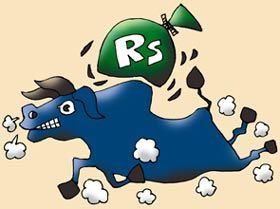
'A fund investor could pick, say, three of the top active funds in any given category,' says Devangshu Datta.
Illustration: Uttam Ghosh/Rediff.com
How do you invest when the market is trading at all-time highs?
Value Research did a study recently on mutual fund returns, between January 2008 and May 2017, to address this question.
January 2008 was a multi-year market peak. It was followed by a bear market, another bull market and another bear market before the present bull market started, some 15 months ago.
In the late stages of a bull market, the study indicates value investors do better than growth-oriented investors.
The best-performing funds during this 113-month period are value-oriented.
Those who focus on relatively smaller-caps also tend to have better returns.
It is also imperative to hold investments made near market peaks for long-time periods.
The first five years (2008 to 2012) saw active funds in the loss.
Net asset values (NAVs) moved above the Jan 2008 levels only in 2013.
Over the 113-month period covered, active large-cap funds averaged a 6.1 per cent compounded annual growth rate (CAGR), while the benchmark Nifty returned 4.6 per cent.
Active mid-caps averaged 9.4 per cent CAGR returns, while the Nifty Free Float Midcap 100 returned 6.77 per cent.
Multi-caps averaged 7.94 per cent, while the Nifty 500 returned 4.6 per cent.
Passive index funds lost out to debt returns: the 364-day government security offered over seven per cent yield during this period.
Those statistics indicate the need to go long-term and also that smaller caps tend to do better.
Many actively managed funds beat their benchmarks, which is unique to India.
The best funds generated far higher returns than the average return in their respective categories.
The top large-cap funds averaged a CAGR between 8.4 per cent and 10 per cent.
The best large-cap performer, Quantum Long-term Equity, hit 12.1 per cent CAGR.
The average active large-cap fund returned 75 per cent in total over 9.5 years, while the best returned 190 per cent.
HDFC Mid-Cap Opportunities (15.3 per cent CAGR), was the mid-cap fund topper, and at least 10 mid-cap fund returned over 10 per cent.
The topper returned 282 per cent while the average mid-cap fund returned 135 per cent.
In mixed cap funds, the topper was ICICI Prudential Value Discovery (14.3 per cent) and eight funds returned over 10 per cent.
The topper generated 252 per cent, while the category average returned 105 per cent.
There could be multiple underlying reasons for the trends in the results.
For example, smaller businesses can grow fast, even in a slowdown.
Also, institutional investors book profits in over-valued stocks.
Hence, while smaller companies get hit hard in the initial stages of bear markets, they are more rewarding in the long term.
Another investment rule can be derived from the wide spread in performances: Be selective.
The top 10 funds in each category have consistently given well above the average returns.
A fund investor could pick, say, three of the top active funds in any given category.
That approach is likely to generate better-than-average returns.
A more ambitious approach could be adopted by the active equity investor.
It is possible to sort through the holdings of top funds, seek out common holdings, and invest in the commonly-held stocks to create a portfolio.
Alternatively, the investor could choose to look at stocks which are held only by one fund, to see if there is something special in these unique holdings.
Working out the details of such a portfolio could be complicated.
Beyond the sorting exercise, (hard in itself), the investor would have to also make calls on allocation weights, timing, etc.
This could be quite an interesting exercise, especially in the universe of mid-caps and multi-caps.
There is a lot of diversity in fund holdings in these categories.
Portfolio variance is more and portfolios have much more diversity for large-caps.
However, even if the investor doesn't want to do this hard work, the study helps to derive some rules that seem simple, but are hard to follow in disciplined ways.
- First, if you invest in a very bullish market, be prepared to hold for a long time.
- Second, look for smaller stocks rather than large-caps in such periods.
- Third, focus on valuations rather than growth.
- Whether you buy mutual funds or equity, be selective.











